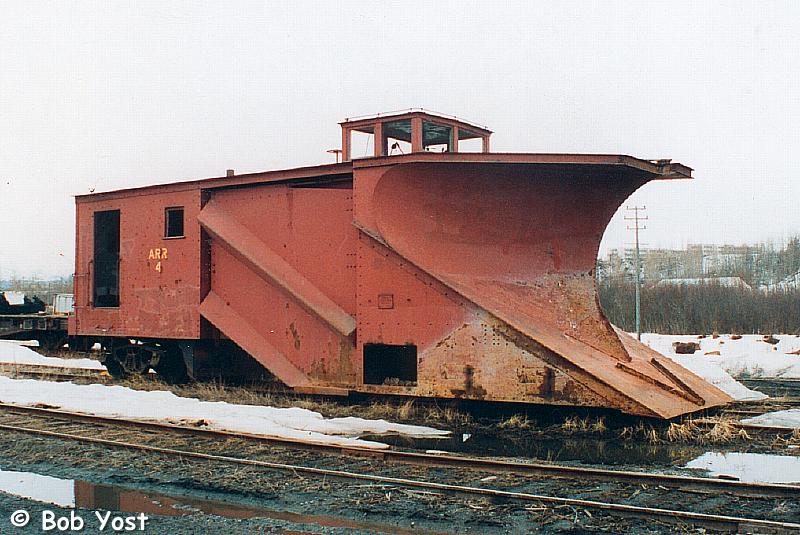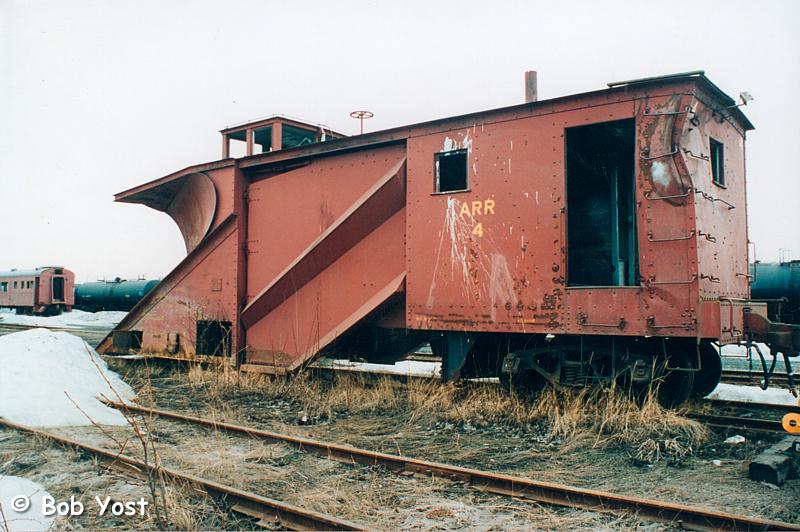|

Russell snowplow number 4. Photo taken in Anchorage
yard on the CEA track 2, outside north end of the old power plant

This snowplow was damaged (cornered) when it was sitting at
the end of the 117 spur and was forgotten. Rather than coupling into the Russell,
a yard crew shoving cars in derailed a car and cornered it. It sat in the
middle of a beaver pond for a long time and right now is at the end of the
ash track in Anchorage.
Photos courtesy of Bob Yost
- Railroading is hard and dangerous work, but even more so in the winter
months. Snow plays havoc with operations, often bringing an entire
line to a standstill. Ice can freeze switch points into a solid mass
or build up so deep in the rail flange that cars and locos will derail.
- Since the first days of railroading, keeping the line open has been backbreaking
job. At first, crews dug out the tracks with picks and shovels. Later,
small pilot plows were fitted on engines during the colder months.
When the snow was light and reasonable speed could be maintained, these
plows were adequate. But for deep or drifting snow, some roads outfitted
their biggest engines with huge plows that stretched to the headlight.
- Deep and frequent snows all but stopped construction of the Central Pacific
in the winter of 1865. Pilot plows couldn't begin to handle the enormous
drifts. The following winter, the first Bucker plow was tried out.
This was basically a big wooden box, riding on freight trucks, and fitted
with a large, wedge shaped front. At first three and later six engines
(more were added if needed) were coupled behind the plow. The train
would get a running start to drive the plow into the drifts, pushing snow
up and away from the tracks. An operator (no doubt a very brave fellow!)
rode on an open platform at the rear of the car, passing hand signals to
the engineer of the lead engine.
- While this design was quite and effective and widely copied, it created
huge walls of hard-packed snow next to the right-of-way. The next
storm would fill in the plowed sections, and the walls made it impossible
to move the snow away from the rail. Various types of spreaders or
pushers were the next development. These cars used a pair of large,
braced wings (which could be folded against the car for transport) to push
the snow back from both sides of the right-of-way.
- The Bucker also did nothing to remove snow and ice from between the rails,
which had to done to prevent derailments. Another machine, called
a flanger, was developed. This was basically a car equipped with
a large shaped mold board. This rode the edges of the rails, breaking
loose accumulations of snow and ice. An operator had to ride the
car, raising and lowering the flanger wherever there was an obstruction
in the rails.
- Railroads were always seeking more economical ways to fight snow, so it
wasn't long before all three designs were combined into one car.
By the early 1900's, the Russell Car and Snow Plow Company of Ridgeway,
Pennsylvania, was a leading supplier of wedge type plows. The design
had been modernized with a cupola and seats for an operator, headlight
for night operations and a pair of air activated side wings to push snow
up and away from the side of the tracks. Wooden bodies were still common,
but within a few years, all steel plows had proven to be more durable.
Both single track (as depicted by this model) and double track (which had
one side of the blade enclosed to prevent snow from being pushed on to
an adjacent track) were offered. Russell continued supplying steel
plows to virtually every railroad that fought snow until early 1950's.
- Since they only see seasonal use, which varies according to the severity
of the winter, and were built tough, many of these veteran snow fighters
are still in service. Often the only modifications have been a conversion
to diesel type headlights, installation of radios and the addition of an
MU plug at the back to provide electrical power. Air for the wings
and brakes is supplied by the locomotive, and some roads have equipped
engines for plow service.
- In operations, plows are run as extra trains, but usually have rights over
all other trains on the line, because of their important mission.
If things are bad enough, they may be the only trains moving at all!
Weather and track condition reports are made by area trains crews, and
the plows are will be ordered by the chief dispatcher when conditions warrant.
The crews are well trained and include the plow operator, the division
roadmaster (who knows the geography and track conditions firsthand), and
the engine crew. Usually several crews are trained to provide relief
if conditions persist. In the steam era, a camp car with a gang of
workers and a tool car carrying shovels and repair parts, often accompanied
the plow. If the plow became stuck or the drift was too deep, the
crew would shovel away the snow by hand until the plow could handle the
job. Today, construction equipment will be brought in to clear the
line if the plows can't handle it.
- The "Russells" as they're called, are considered a vital part of the work
train fleet, and are either painted in standard maintenance colors, or
sport a bright scheme to contrast with the snow for added safety.
In snow country, each division of a railroad will usually be assigned at
least one plow (and possibly a flanger to handle lighter storms) which
is kept at a strategic terminal.
Thanks to Wm
K. Walthers, Inc. for allowing me to reprint
their information.
Thanks to Robert Krol for typing in this information
and sending it to me!
See also:
|

